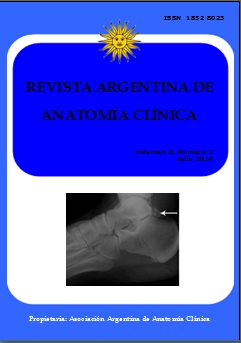BILATERAL FORAMINA ON THE POSTERIOR ARCH OF THE ATLAS. Foramina bilateral en el arco posterior del atlas
DOI:
https://doi.org/10.31051/1852.8023.v6.n2.14130Palabras clave:
atlas, foramen, posterior arch, congenital anomalies, orificio, arco posterior, anomalías congénitasResumen
Durante la disección de la región cervical de diez cadáveres (5 varones y 5 mujeres, con edad media de 81,66 años) de una población de Escocia, se observaron dos especímenes con canales bilaterales de las arterias vertebrales y otro ejemplar con un canal vertebral unilateral en el arco posterior del atlas (C1). En estas muestras, se observó que la tercera parte de las arterias vertebrales pasan a través del foramen accesorio ubicado en el arco posterior del atlas. Anomalías del atlas y la arteria vertebral no son comúnmente reportadas en la literatura; sin embargo, son importantes debido a su importancia en el diagnóstico y tratamiento clínico. Forámenes bilate-rales en el arco posterior de C1 no se han informado anteriormente en una población escocesa. Para los neurocirujanos y radiólogos la presencia de este rasgo no métrico es importante a la hora de realizar operaciones o en la interpretación de esta zona de la anatomía.
During dissection of the cervical region of ten cadavers (5 males, 5 females: mean age 81.66 years) from a Scottish population, two specimens were observed to have bilateral vertebral artery canals and a further specimen had a unilateral vertebral canal on the posterior arch of the atlas (C1): in these specimens the third part of the vertebral artery passed through the accessory foramen. Anomalies of the atlas and vertebral artery are not commonly reported in the literature; however they are important due to their significance in clinical diagnosis and treatment. Bilateral foramina in the posterior arch of C1 have not been previously reported in a Scottish population. The presence of this non-metric trait is important for neurosurgeons and radiologists who may be operating on or interpreting this area of anatomy.
Descargas
Citas
Barsukov SF, Antonov GI. 1992. Kimmerle’s anomaly and stroke. Voen Med Zh Oct 10: 32-36.
Cushing KE, Ramesh V, Gardner-Medwin D, Todd NV, Gholkar A, Baxter P, Griffiths PD. 2001. Tethering of the vertebral artery in the congenital arcuate foramen of the atlas vertebra: a possible cause of vertebral artery dissection in children. DMCN 43: 491-96.
De Zoete A, Langeveld UA. 2007. A congenital anomaly of the atlas as a diagnostic dilemma: a case report. JMPT 30: 62-64.
Dwight T. 1887. Account of two spines with cervical ribs, one of which has a vertebra suppressed, and absence of the anterior arch of the atlas. J Anat 21: 539–50.
Gehweiler JA, Daffner RH, Roberts L. 1983 Malformations of the atlas vertebra simulating the Jefferson fracture. AJR 140: 1083-86.
Hasan M, Shukla S, Siddiqui MS, Singh D. 2001. Posterolateral tunnels and ponticuli in human atlas vertebrae. J Anat 199: 399-43.
Huang MJ, Glaser JA. 2003. Complete arcuate foramen precluding C1 lateral mass screw fixation in a patient with rheumatoid arthritis: case report. Iowa Orthop J 23: 96-99.
Koutsouraki E, Avdelidi E, Michmizos D, Kapsali S-E, Costa V, Baloyannis. 2010. Kimmerle’s anomaly as a possible causative factor of chronic tension-type headaches and neurosensory hearing loss: case report and literature report. International journal of Neuroscience 120: 236-39.
Moore KL, Dalley AF, Agur AMR. 2010. Clinical Oriented Anatomy. 6th edition, Philadelphia, Lippincott William and Wilkins, 1-1168.
Nayak SB. 2008. Abnormal foramina on the posterior arch of the atlas vertebra. IJAV 1: 21-22.
Nayak S. 2007. Bilateral absence of foramen transversarium in atlas vertebra: a case report. Neuroanatomy 8: 28-29.
Nayak S, Vollala VR, Raghunathan D. 2005. Total fusion of atlas with occipital bone: a case report. Neuroanatomy 4: 39-40.
Nayak UV. 1931. A case of abnormal atlas and axis vertebra. J Anat 65: 399-400.
Palastanga N, Field D, Soames R. 2006. Anatomy and Human Movement: structure and function, 5th edition, Edinburgh, Butterworth Heinemann Elsevier, 1-734.
Parakash BS, Padma LK, Mamatha Y, Ramesh BR. 2010. Left arteriae vertebralis canal in atlas-Kimmerle anomaly. . IJAV 3: 130-31.
Scheuer L, Black S. 2000. Developmental Juvenile Osteology, Elsevier Academic Press, 1-587.
Shinde VS, Mallikarjun M. 2012. Study of abnormal foramen over the posterior arch of atlas vertebra. Int. J. Morphol. 2: 557-58.
Smit RAJ, Coebergh JAF, Treurniet FEE, Kuiters RRF, Koppen H. 2013. A missing arch of the atlas vertebra in a patient struck by a tram. NS. 34: 1855-56.
Split W, Sawrasewicz-Rybak M. 2002. Character of headache in Kimmerle anomaly. Headache 42: 911–16.
Standring S. 2008. Gray`s Anatomy: The Anatomical Basis of Clinical Practice, 40 edition, Churchill Livingstone Elsevier 1-1576.
Young JP, Young PH, Ackermann MJ, Anderson PA, Riew KD. 2005. The ponticulus posticus: implications for screw insertion into the first cervical lateral mass. JBJS 87: 2495-98.
Descargas
Publicado
Cómo citar
Número
Sección
Licencia
Los autores/as conservarán sus derechos de autor y garantizarán a la revista el derecho de primera publicación de su obra, el cuál estará simultáneamente sujeto a la Licencia de reconocimiento de Creative Commons que permite a terceros compartir la obra siempre que se indique su autor y su primera publicación en esta revista. Su utilización estará restringida a fines no comerciales.
Una vez aceptado el manuscrito para publicación, los autores deberán firmar la cesión de los derechos de impresión a la Asociación Argentina de Anatomía Clínica, a fin de poder editar, publicar y dar la mayor difusión al texto de la contribución.



